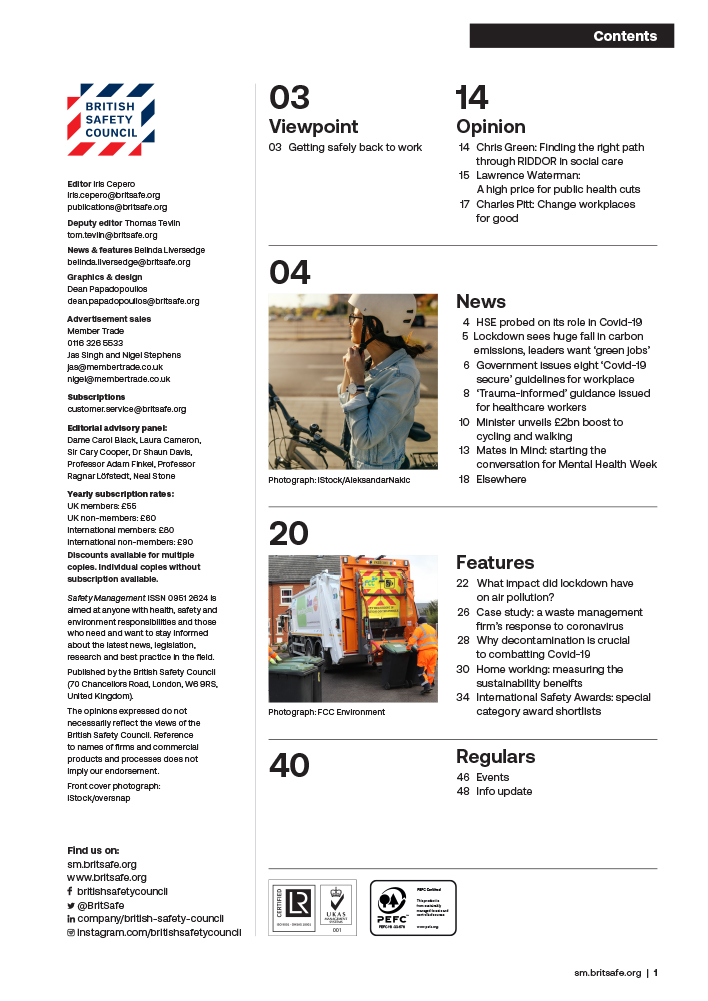Lithium-ion batteries used to power equipment such as e-bikes and electric vehicles are increasingly linked to serious fires in workplaces and residential buildings, so it’s essential those in charge of such environments assess and control the risks.
Features
Lithium-ion batteries: a growing fire risk
Lithium-ion batteries are now firmly part of daily life, both at home and in the workplace. They are in portable devices, electric vehicles and renewable energy storage systems. Lithium-ion batteries have many advantages, but their safety depends on how they are manufactured, used, stored and recycled.
 Photograph: iStock/aerogondo
Photograph: iStock/aerogondo
Fortunately, Lithium-ion battery failures are relatively rare, but in the event of a malfunction, they can represent a serious fire risk. They are safe products and meet many EN standards. However, when charged, Li-ion cells store a large amount of energy and are especially sensitive to high temperatures and damage, such as penetration and crushing.
If a battery degrades, gets hot, or suffers a short circuit, heat and pressure build up inside. Warning signs that a battery is likely to fail include bulging or swelling, sometimes accompanied by other signs such as discharging too fast and/or the battery being hot to the touch.
What goes wrong?
At a certain level, the chemical reaction creates thermal runaway, causing rapid overheating and quickly affecting adjacent cells. Batteries will spontaneously ignite, burning at extremely high temperatures of between 700◦c and 1000◦c, and releasing dangerous off gases that in enclosed spaces can become a flammable vapour cloud explosion (VCE).
The temperatures involved and the sparks generated cause a fire, further fuelled by the vented gases as the battery cells decompose further, resulting in rapid fire spread. This process happens far more quickly than in any other type of fire.
The reactions, once started, increase so speedily that the cells typically appear to ‘explode.’ Due to the self-sustaining process of thermal runaway, Lithium-ion battery fires are also difficult to quell. Bigger batteries such as those used in electric vehicles may reignite hours or even days after the event, even after being cooled.
 Source: Firechief® Global
Source: Firechief® Global
Current data suggests that in 2023, 338 fires involving Lithium-ion batteries were caused by e-bikes, and e-scooters¹. In the UK, Lithium-ion batteries discarded in domestic and business waste are responsible for an estimated 201 fires a year. This figure is increasing weekly, meaning that 48 per cent of all waste fires now cost the UK economy £158m per annum². Furthermore, a European study suggests that by 2025, 78 million Lithium-ion batteries could be discarded daily worldwide³.
Over the past four years, insurance companies have changed the status of Lithium-ion batteries and the devices which contain them, from being an emerging fire risk to a recognised risk, therefore those responsible for fire safety in workplaces and public spaces need a much better understanding of this risk, and how best to mitigate it.
Fire risk assessments and Lithium-ion batteries
The Regulatory Reform (Fire Safety) Order 2005 covers fire safety legislation for non-domestic premises. This means that the Responsible Person (RRP), generally the owner, employer, or occupier, is required to actively pursue and maintain fire safety and take responsibility for staff and visitors on their premises. This includes a legal requirement for a fire risk assessment, undertaken by a competent person, which looks at the premises as a whole and takes into consideration the potential risks.
A typical workplace or public space is likely to have many devices containing Lithium-ion batteries so it makes sense to assess the fire risk these could pose should the worst happen, and then have an action plan in place to mitigate those risks. Some Lithium-ion battery risks are mobile, others are static. It might be the handling of Lithium-ion batteries that’s a risk or the batteries may be damaged; they may be brand new; they may be low in charge; they may potentially be highly charged.
Identifying the scale of the risk present could simply mean the number of Lithium-ion batteries being stored. This will include any old laptops which have been returned by employees. Could these be recycled rather than stored perhaps? Where is the EV fleet being charged? Is it next to or near fire exits? Are staff allowed to bring e-bikes or e-scooters on to site? Are they allowed to charge them on site? It’s about identifying the scale of the risk present.
Lack of awareness
Despite the growing incidence of fires involving Lithium-ion batteries, there is a gap between these incidents and the awareness of the risks on the part of health and safety professionals and fire risk assessors. A survey of more than 500 organisations carried out between September 2023 and February 2024 revealed that 71 per cent of respondents had not updated their fire risk assessments to cover the risk of Lithium-ion battery fires, with just 15 per cent having done so and a further 14 per cent unsure.
Education leading to awareness and understanding of the risks involved is needed, along with a change in mindset and attitudes towards these batteries and devices, The findings from any fire risk assessment should provide recommendations on how to ensure that Lithium-ion batteries are handled, used, stored or charged safely, and these must be aligned to provide a strategy for fire risk management.
 Matt Humby is senior technical consultant at Firechief® Global. Photograph: Firechief® Global
Matt Humby is senior technical consultant at Firechief® Global. Photograph: Firechief® Global
To help mitigate the risk of Lithium-ion battery fires, Firechief® Global has developed a proprietary eight-step Halo™ Battery Safety Action Plan which includes proactive actions, such as assessing the scale of risk that’s present in the organisation and/or its environment, and a range of reactive actions to deal with a Lithium-ion battery thermal event.
Some things can be achieved very easily and quickly, while other areas may take some time. Overall, the key is to understand the particular risks posed by Lithium-ion batteries in your organisation and environment, and then take action to manage them. Education and awareness are the first steps in understanding the mindset change needed to become Lithium-ion battery-safe, not only within the workplace but also in the home.
Guidance, standards and regulation
While there are standards for the overall performance and safety of Lithium-ion batteries, there are as yet no UK standards specifically for their fire safety performance. IEC 62133 sets out requirements and tests for the safety and performance of Lithium-ion batteries in portable electronic devices, including cell phones, laptops and tablets.
The standard covers various aspects of battery safety, including electrical, mechanical and chemical safety, and is used by manufacturers and other stakeholders. The standard covers issues such as overcharging, over-discharging, short circuiting and thermal runaway, so does cover some aspects of fire hazards. Other standards for Lithium-ion batteries include UL-1642 and UL-9540.
Meanwhile, the charity, Electrical Safety First, is championing proposed legislation on the safety of lithium batteries. The Safety of Electric-Powered Micromobility Vehicles and Lithium Batteries Bill covers three main areas:
- Safety assurance: mandating a safety assessment by a UK government-approved body for all e-bikes, e-scooters and their Lithium-ion batteries before they enter the UK market
- Responsible disposal: requiring the UK Government to make regulations for the safe disposal of Lithium batteries at the end of their lifecycle
- Comprehensive fire safety: the UK Government to have responsibility for enhancing safe usage, charging and storage practices for products, including setting standards for conversion kits and charging systems, and considering a temporary ban on the sale of universal chargers that heighten fire risks.
The bill has been drafted in collaboration with key partners, including the National Fire Chiefs Council, London Fire Brigade and Zurich insurance, and is widely supported by a large number of organisations, including Firechief® Global.
Lithium-ion battery safety good practice:
Many of the precautions that can be taken are simple to implement, but typical recommendations include:
- Only use equipment and chargers supplied by reputable manufacturers
- Make frequent inspections of batteries for signs of damage
- Never use damaged or defective batteries
- Ensure battery handling and storage areas are dry, cool, well-ventilated, and free from high levels of humidity
- Ensure battery handling and storage areas are free from flammable or combustible materials and sharp objects, and that batteries are not left in contact with conductive materials
- Ensure battery charging is well managed by trained staff, making sure that batteries are removed from chargers after charging is complete, and that batteries are not left on charge in un-occupied locations
- Train staff on emergency procedures and specific instructions for dealing with damaged or faulty batteries. Staff should be aware of their own safety in relation to dealing with fires involving Lithium-ion batteries
- Keep batteries not in use in appropriate containers, such as a proprietary metal battery storage cabinet or fireproof safety bags
- Limit the size of storage areas, and ensure they are dedicated to Lithium-ion battery storage only
- Reduce the potential for thermal runaway by reducing the State of Charge (SOC) of Lithium-ion batteries and devices containing them
Matt Humby is senior technical consultant at Firechief® Global.
The Firechief® Academy runs two CPD-accredited courses, to help fire and safety professionals understand and manage the fire risks associated with Lithium-ion batteries:
An Introduction to the Burning Issues Surrounding Lithium-ion Battery Fires
Is our Reliance on Lithium-ion Batteries Safe or Sustainable?
More resources:
Lithium-ion battery safety podcast
The Firechief® YouTube channel features videos showing different types of Lithium-ion battery fires
References
- Department for Transport published Guidance Document: E-Cycle and E-Scooter Batteries: Managing Fire Risk for Premises. February 2024, tinyurl.com/2ub5fexu
- Eunomia and the Environmental Services Association (ESA): Cutting Lithium-ion Battery Fires in the Waste Industry 2021
- The Community Research & Development Information Service (CORDIS) EU Research body



